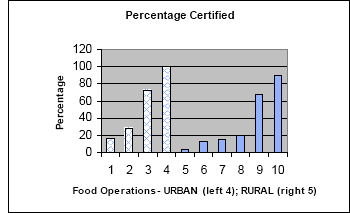| Alberta Workforce Essential Skills (AWES) | Impact Study: Essential Skills and Food Sanitation and Hygiene Training |
Quantifiable information about employees in the case studies who have completed the training leading to certification is presented in the table and chart. The number of foodservice employees who are certified varies from 3% to 100% of the employee base. Employees who hold a certificate may be owners, cooks, kitchen staff, front end staff, food aides, and supervisory or administrative staff. The table below distinguishes between urban and rural operations.

Operation |
Percentage of employees certified |
|
|---|---|---|
Urban centres |
1 |
16% |
2 |
28% |
|
3 |
72% |
|
4 |
100% |
|
Small town and rural centres |
5 |
3% |
6 |
13% |
|
7 |
15% |
|
8 |
20% |
|
9 |
67% | |
10 |
90% |
|
11 |
Not available |
As an additional data gathering resource, ATEC conducted a telephone interview with contacts at fifteen food properties in Edmonton. Managers were asked about 1) the food safety training courses that are offered to their staff and 2) the number of staff who had taken the training. The targeted operations included five hotels, four speciality restaurants, one fine dining restaurant, and four casual/family chain restaurants.
Results indicate that hotel dining rooms employ workers who have food safety training and in most cases certification. Chain restaurants are similar to hotels in that the employees tend to have training in food safety but not necessarily the certification. High end restaurants employ chefs who are red seal certified and thus, are not inclined to provide training courses.